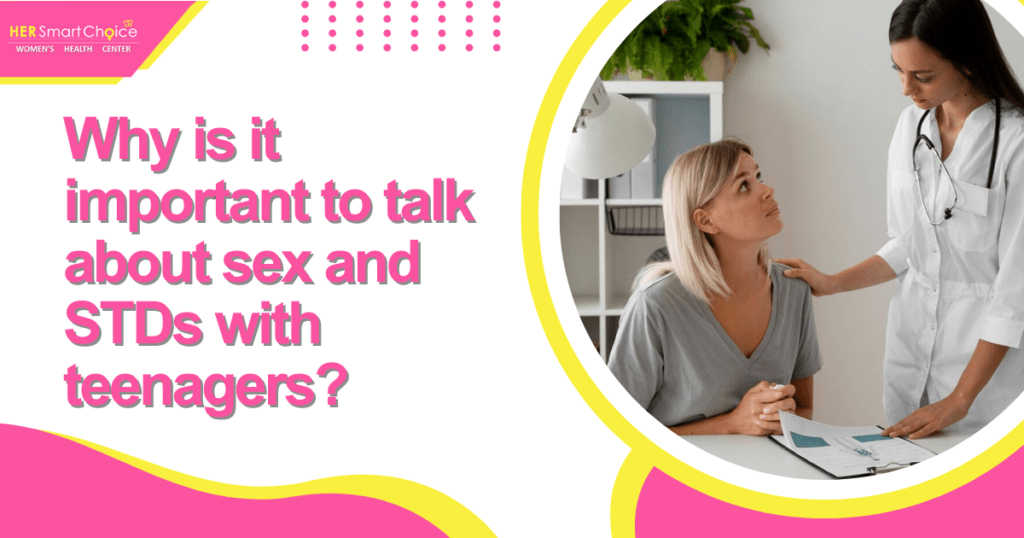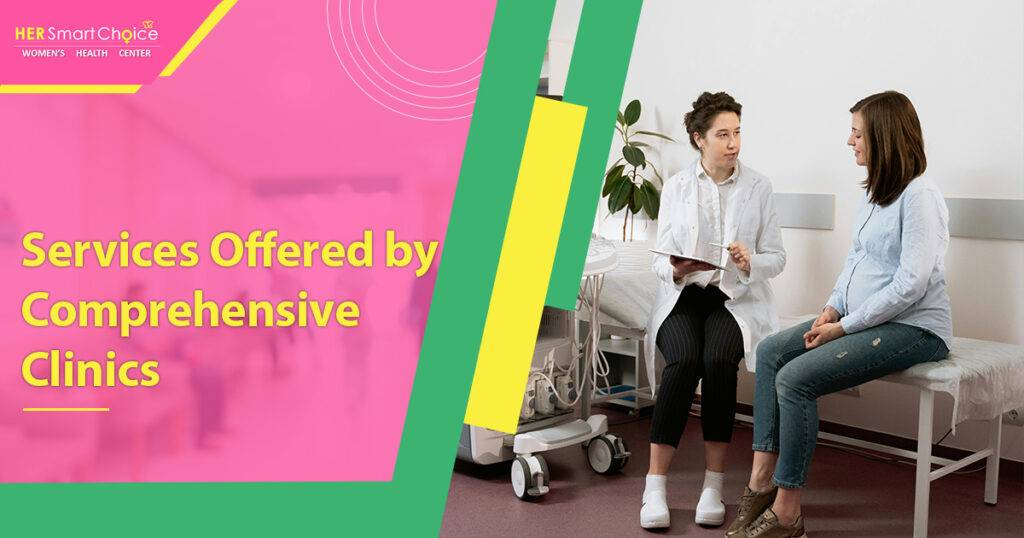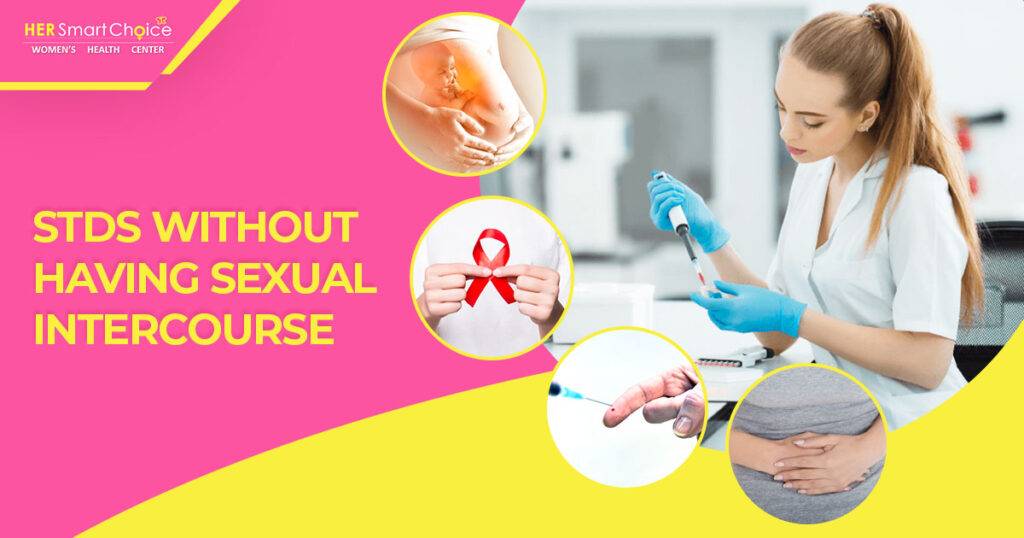Why Do You Need to Get Tested For STDs? – Understanding the Importance of STD Testing for Your Health and Community
Her Smart Choice Women’s Health Center Educational Series Presents ‘Why Do You Need to Get Tested For STDs?’ Why Do You Need to Get Tested For STDs?
Follow Us!
More than 2.5 million sexually transmitted infections were reported in the U.S. in 2021, yet many remain silent without noticeable symptoms. Getting tested for STDs is crucial for early detection, treatment, and preventing transmission—protecting both individual wellness and community health. In this article, you will discover:
- What hidden dangers arise when STDs go untested
- How personal health benefits—from preserving fertility to reducing HIV risk—depend on regular screening
- Who should get screened and how often based on behavior and life stage
- What to expect during the testing process, including types of tests and confidentiality safeguards
- How STD testing breaks transmission chains and supports public health initiatives
- The serious consequences of skipping testing
- Clear next steps after you receive your results
By mapping these themes, you’ll gain actionable insight into why STD testing is a foundational component of sexual health and preventative care.
STD Prevalence in the U.S.
In 2021, over 2.5 million cases of sexually transmitted infections were reported in the United States, highlighting the significant public health burden of STIs. Many STIs often present without noticeable symptoms, making testing crucial for early detection and treatment.
Centers for Disease Control and Prevention, Sexually Transmitted Disease Surveillance 2021 (2022)
This source provides the statistical context for the prevalence of STIs, which is a foundational element of the article’s introduction.
What Are the Hidden Dangers of Untested STDs?
Many sexually transmitted infections show no warning signs, making routine STD testing the only reliable method for detection, timely intervention, and preventing irreversible damage.
Why Can STDs Go Undetected Without Testing?
An asymptomatic infection is a medical condition that produces no obvious symptoms but can still cause tissue damage and spread to others. For example, Chlamydia trachomatis often infects the reproductive tract quietly, leading to inflammation that, if unaddressed, progresses to pelvic inflammatory disease. Recognizing this silent nature underscores why routine screening is essential to halt complications before they arise and to protect sexual partners.
Which Common STDs Are Often Asymptomatic?
Before presenting symptoms, several STDs remain hidden, requiring testing to confirm infection.
- Chlamydia
- Gonorrhea
- Human papillomavirus (HPV)
- Herpes simplex virus (HSV)
- Syphilis in latent stages
These infections can persist undetected, elevating the risk of complications and spread. Regular screening transforms invisibility into actionable diagnosis, enabling prompt treatment.
What Are the Early Signs and Symptoms to Watch For?
Although many STDs are silent, some indicators can emerge early:
- Unusual discharge from genitals or rectum
- Painful or frequent urination
- Genital itching, sores, or blisters
- Lower abdominal pain in women
- Skin rashes or swollen lymph nodes
Noticing any of these warrants immediate testing. Detecting an infection at its onset minimizes tissue damage and accelerates recovery, while also guiding partners to get screened.
How Does Early Detection Prevent Serious Health Issues?
Early STD detection enables targeted therapy that stops infection progression, reduces inflammation, and preserves organ function. Untreated gonorrhea and chlamydia, for instance, can ascend to the uterus and fallopian tubes, causing pelvic inflammatory disease and infertility. Prompt antibiotic treatment interrupts this pathway, safeguarding reproductive health and preventing costly long-term complications.
Benefits of Early STD Detection
Early detection of STDs enables timely intervention, which can prevent serious health issues. Prompt treatment can stop the progression of infections, reduce inflammation, and preserve organ function, thereby preventing long-term complications such as infertility and pelvic inflammatory disease.
Workowski, K. A., & Bolan, G. A., Sexually transmitted diseases treatment guidelines, 2015. (2015)
This citation supports the article’s claims about the importance of early detection and treatment in preventing severe health outcomes.
What Are the Personal Health Benefits of Getting Tested for STDs?
Routine STD testing provides direct advantages that preserve fertility, reduce cancer risk, lower HIV susceptibility, and maintain sexual well-being.
How Does Testing Prevent Long-Term Complications Like Infertility and PID?
Identifying infections early interrupts pathological mechanisms that lead to pelvic inflammatory disease (PID) and fallopian tube scarring.
| STD | Potential Complication | Mechanism |
|---|---|---|
| Chlamydia | Pelvic Inflammatory Disease (PID) | Bacterial ascent causes tubal scarring |
| Gonorrhea | Infertility | Chronic inflammation impairs cilia |
| Syphilis | Organ damage | Spirochete invasion leads to tissue lesions |
Intervening during asymptomatic stages halts these mechanisms, ensuring reproductive structures remain functional and reducing infertility rates.
What Is the Link Between STDs and Increased Cancer Risk?
Certain viral STDs integrate into host DNA and drive malignant transformation. Human papillomavirus (HPV), for example, produces oncoproteins that inactivate tumor suppressor genes, increasing risk for cervical, anal, and oropharyngeal cancers. Detecting high-risk HPV strains through Pap smears and DNA tests enables early treatment of precancerous lesions, markedly reducing cancer incidence.
How Does STD Testing Reduce Your Risk of Contracting HIV?
Open wounds and mucosal inflammation caused by untreated STDs create entry portals for HIV. By diagnosing and treating infections like herpes simplex virus or syphilis, testing eliminates these co-infection risk factors. Regular screening thus serves as an indirect HIV prevention strategy that complements barrier methods and pre-exposure prophylaxis.
How Can Testing Protect Your Reproductive and Sexual Health?
Routine STD screening supports healthy pregnancies by identifying infections—such as syphilis or HIV—that can transmit to the fetus. It also preserves sexual function by preventing chronic pain syndromes associated with nerve involvement in untreated infections. In this way, testing empowers informed reproductive planning and enhances long-term sexual satisfaction.
Who Should Get Tested for STDs and How Often?
Universal and risk-based recommendations ensure appropriate screening intervals that catch infections early and sustain sexual health.
What Are the General Testing Recommendations for Sexually Active Individuals?
All sexually active people should undergo regular STD screening as a preventive health measure.
| Demographic | Recommended Tests | Frequency |
|---|---|---|
| Ages 13–64 | HIV antibody/antigen | At least once lifetime |
| Sexually active women < 25 years | Chlamydia & Gonorrhea (nucleic acid tests) | Annually |
| All pregnant individuals | Syphilis, HIV, Chlamydia, Gonorrhea | First prenatal visit |
STD Testing Recommendations
The Centers for Disease Control and Prevention (CDC) provides guidelines for STD screening, recommending that all sexually active individuals undergo regular testing. Specific recommendations vary based on age, sex, and risk factors, such as the frequency of testing for different demographics.
Centers for Disease Control and Prevention, STD Screening Recommendations (2024)
This citation provides the basis for the article’s recommendations on who should get tested and how often, which is a key section of the article.
Which Specific Groups Need More Frequent Testing?
Certain populations face elevated risk and benefit from intensified screening:
- Individuals with multiple or anonymous partners (every 3–6 months)
- Men who have sex with men (MSM) for syphilis, chlamydia, and gonorrhea (every 3 months)
- People living with HIV to monitor co-infections (clinician-determined intervals)
- Pregnant women beyond first trimester if new risk factors emerge
Focusing on these groups maximizes early detection in high-risk scenarios and reduces community prevalence.
How Does Sexual Behavior Influence Your Testing Schedule?
Behaviors such as unprotected sex, inconsistent barrier use, or partner concurrency directly increase exposure to STDs. Each new sexual partner or lapse in protection raises the probability of acquiring an infection, making it essential to test soon after possible exposures and to follow up after the window period for reliable results.
Why Is Regular Testing Important Even Without Symptoms?
Yes, regular testing is vital in the absence of symptoms because most STDs can remain latent while causing subclinical damage. Routine screening uncovers these hidden infections and prevents long-term sequelae, breaking silent transmission chains and ensuring interventions are not delayed until irreversible harm occurs.
What Should You Expect During STD Testing? – Types, Procedures, and Confidentiality
STD testing combines straightforward procedures with robust privacy measures to deliver accurate results and protect patient information.
What Are the Common Types of STD Tests?
Healthcare providers employ different specimen collection methods based on the infection being screened.
| Test Type | Specimen | Purpose |
|---|---|---|
| Blood | Venipuncture | Syphilis serology, HIV antigen/antibody |
| Urine | Voided sample | Chlamydia & Gonorrhea nucleic acid tests |
| Swab | Genital swab | HPV DNA, Herpes PCR, Trichomoniasis |
How Is Confidentiality Maintained During Testing?
Clinics adhere to privacy protocols and regulations, such as HIPAA in the U.S., to protect patient data. Key measures include:
- Unique patient identifiers instead of names on lab specimens
- Secure electronic medical records with access controls
- Discreet billing codes or sliding-scale payments to reduce stigma
By safeguarding personal information, testing services encourage more people to seek screening without fear of exposure.
What Is the Window Period and When Should You Retest?
The window period is the time between exposure and when a test can reliably detect infection. For example:
- HIV antigen/antibody: 18–45 days post-exposure
- Syphilis serology: 3–6 weeks
- Chlamydia/Gonorrhea NAAT: 7–14 days
Retesting after the recommended window ensures accurate results, preventing false negatives and guiding appropriate follow-up care.
How Can You Prepare for an STD Test?
Before your appointment, you can improve testing accuracy by:
- Avoiding urination for at least one hour prior to a urine-based NAAT
- Refraining from intercourse, douching, or vaginal products 24 hours before sampling
- Listing recent sexual encounters and partner details for clinical context
- Bringing valid identification and insurance or payment method
Being prepared streamlines the process, reduces discomfort, and maximizes the reliability of your results.
How Does STD Testing Help Prevent Transmission and Promote Public Health?
Testing serves as a cornerstone of community health initiatives, disrupting infection cycles and informing prevention strategies.
How Does Testing Break the Chain of STD Transmission?
By identifying infected individuals—often before they experience symptoms—healthcare providers can administer treatment and counsel on safer sexual practices. This interruption of infectious periods reduces onward transmission, effectively lowering community prevalence and protecting vulnerable population segments.
Why Is Open Communication About Testing Important Among Partners?
Transparent discussions about STD status foster mutual trust, encourage joint testing, and normalize prevention efforts. When partners share results and testing histories, they can make informed decisions about barrier methods, treatment adherence, and timing of intimate activities, strengthening relationship health in the process.
What Are the Broader Public Health Benefits of Widespread Testing?
Widespread screening contributes to:
- Surveillance data that guide resource allocation and targeted interventions
- Reduced healthcare costs by preventing costly complications
- Enhanced community awareness, destigmatizing sexual health conversations
- Measurable declines in STD incidence and potential eradication of treatable infections
These systemic benefits cascade from individual choices to large-scale health outcomes.
How Do Vaccinations Complement STD Prevention Efforts?
Vaccines against HPV and Hepatitis B significantly lower the incidence of vaccine-preventable infections. When combined with regular screening, immunization programs reduce both the burden of disease and the risk of co-infection, creating a multilayered prevention framework that preserves long-term health.
What Are the Risks and Consequences of Not Getting Tested for STDs?
Forgoing STD screening exposes individuals and communities to avoidable health crises and emotional strain.
What Happens If You Don’t Get Tested for STDs?
Untreated infections can progress silently, leading to chronic pain, organ damage, infertility, and increased risk of life-threatening conditions such as HIV or certain cancers. Moreover, individuals may unknowingly transmit infections to partners, perpetuating infection cycles and amplifying public health burdens.
How Can Untreated STDs Affect Pregnancy and Newborns?
Maternal infections like syphilis or HIV can cross the placenta or transfer during childbirth, causing miscarriage, stillbirth, or congenital disorders. Early detection and treatment in pregnant people dramatically reduce these perinatal complications and safeguard newborn health.
What Are the Emotional and Psychological Impacts of Delayed Testing?
Delaying testing can trigger anxiety, guilt, and relationship stress, especially if a diagnosis occurs at an advanced stage. Proactive screening empowers individuals with timely information, alleviating uncertainty and fostering a sense of control over one’s sexual health.
How Can Early Testing Improve Treatment Outcomes?
Yes, early testing allows for simpler, shorter treatment courses—such as a single antibiotic dose for chlamydia—instead of prolonged regimens. Timely intervention minimizes tissue damage, enhances quality of life, and lowers the risk of recurrent or chronic infection.
What Are the Next Steps After Getting Tested for STDs?
Receiving your test results marks the start of an informed care plan, whether that involves treatment, partner communication, or future screening.
What Should You Do If Your Test Is Positive?
Begin prescribed therapy promptly, attend follow-up appointments to confirm clearance, and comply with partner notification guidelines. Effective treatment regimens are available for bacterial STDs, while viral infections may require suppressive or prophylactic medications to manage symptoms.
How Can You Talk to Your Partner About STD Testing?
Approach conversations with empathy and clarity:
- Share your results factually and without blame
- Invite your partner to test together or separately
- Focus on health and prevention rather than morality
- Offer resources or clinic information to facilitate their screening
Open dialogue promotes mutual responsibility and reduces stigma.
When Should You Schedule Your Next Test?
Re-screen at intervals based on risk:
- Six to twelve months for routine follow-up after clearance
- Three months after high-risk exposures or new partnerships
- According to clinician recommendations if symptoms reappear
Consistent testing reinforces a preventive mindset and catches reinfections early.
Where Can You Find Reliable Testing and Support Services?
Access confidential testing and counseling through:
- Local public health clinics or community health centers
- Certified family planning providers and sexual health clinics
- Primary care offices and telehealth services offering at-home test kits
- National hotlines and websites such as the CDC’s STD testing locator
Early and regular STD testing is a proactive step that secures your own health, protects those you care about, and strengthens community well-being. Schedule your screening today to take control of your sexual health and contribute to broader public health efforts.
Frequently Asked Questions
If you receive a positive STD test result, it’s essential to start treatment as prescribed by your healthcare provider immediately. Follow-up appointments are crucial to ensure the infection is cleared. Additionally, inform your sexual partners about your diagnosis so they can also get tested and treated if necessary. Open communication about your health status can help prevent further transmission and promote a supportive environment for both you and your partners.
Encouraging your partner to get tested can be approached with empathy and understanding. Start by sharing your own testing experience and the importance of maintaining sexual health. Suggest testing together to normalize the process and reduce any stigma. Emphasize that testing is a responsible step for both of you, focusing on health rather than blame. Providing resources or information about local clinics can also help facilitate their decision to get tested.
The costs of STD testing can vary widely depending on the type of test, the healthcare provider, and whether you have insurance. Many public health clinics offer low-cost or sliding-scale fees based on income. Some insurance plans cover STD testing, especially if it’s deemed medically necessary. It’s advisable to check with your insurance provider and local clinics to understand the costs involved and any available financial assistance options.
If you have multiple sexual partners, it is recommended to get tested for STDs every 3 to 6 months. This frequent testing helps ensure early detection and treatment of any infections, reducing the risk of transmission to others. Regular screening is a proactive approach to maintaining your sexual health and the health of your partners. Always consult with your healthcare provider for personalized recommendations based on your specific circumstances.
Untreated STDs can lead to severe health complications, including chronic pain, infertility, and increased susceptibility to other infections, such as HIV. For women, untreated STDs can cause pelvic inflammatory disease (PID), which can result in long-term reproductive issues. In both genders, untreated infections can lead to organ damage and other serious health conditions. Regular testing and prompt treatment are crucial to prevent these adverse outcomes and maintain overall health.
Yes, many clinics and health centers offer STD testing without the need for a doctor’s referral. You can visit public health clinics, sexual health clinics, or even some pharmacies that provide testing services. Additionally, telehealth services may offer at-home testing kits that allow you to collect samples privately and send them for analysis. Always ensure that the testing facility is reputable and follows proper confidentiality protocols.
To reduce the risk of STDs, consider adopting safer sexual practices such as using condoms consistently and correctly, limiting the number of sexual partners, and engaging in mutual monogamy with a tested partner. Regular STD testing is also crucial for early detection and treatment. Additionally, maintaining open communication with partners about sexual health and history can foster a safer sexual environment. Vaccinations for preventable STDs, like HPV and Hepatitis B, are also recommended.
Conclusion
Regular STD testing is essential for safeguarding your health and the well-being of your community, as it enables early detection and treatment of infections. By understanding the personal health benefits and the broader public health implications, you can take proactive steps to prevent serious complications. Don’t wait for symptoms to appear; prioritize your sexual health by scheduling a test today. Explore local clinics and resources to find the right testing options for you.
To Schedule an Appointment, Click Here
For additional information, please visit www.HerSmartChoice.com or call 323-250-9360.
Get SOCIAL with us!
Her Smart Choice
Your Life. Your Decision. Your Smart Ch♀ice.




























